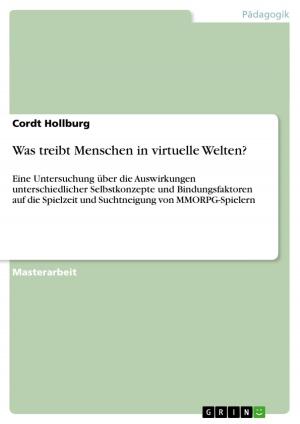The Development of the Detective in American 'hard-boiled' Fiction with Reference to Philip Marlowe in Raymond Chandler's 'The Curtain', 'Killer in the Rain' and 'The Big Sleep'
Nonfiction, Entertainment, Drama, Anthologies| Author: | Katrin Gischler | ISBN: | 9783638441452 |
| Publisher: | GRIN Verlag | Publication: | November 22, 2005 |
| Imprint: | GRIN Verlag | Language: | English |
| Author: | Katrin Gischler |
| ISBN: | 9783638441452 |
| Publisher: | GRIN Verlag |
| Publication: | November 22, 2005 |
| Imprint: | GRIN Verlag |
| Language: | English |
Seminar paper from the year 2004 in the subject American Studies - Literature, grade: 2, University of Kassel (Anglistik-Amerikanistik), course: American Crime Fiction, 14 entries in the bibliography, language: English, abstract: Raymond Thornton Chandler started his career as a crime novelist relatively late in 1933 at the age of 45 (Widdicombe, xvi). With the foundation of the Black Mask Magazine, Chandler, as well as many other writers, got the chance to test his talent as a crime novelist and simultaneously to raise some money. His first stories were miniature novels which were strongly influenced by his British sophistication and education (Phillips, 17). But he was aware of the fact that he had to veil his style of writing in order to make it acceptable to the American readers, especially the Black Mask readers (Phillips, 17). During 1933 and 1939 Chandler published 20 detective stories in several 'pulp magazines' until he wrote his first novel The Big Sleep (Neumeyer, 329). By writing longer fiction Chandler had to portray his characters fully and give an authentic sense of the world, whereas the short story allowed him to rely on action (MacShane, 63). Chandler's ambition was to mark off from the English detectives of Agatha Christie and Dorothy Sayers, i.e. to create a reliable character that would 'leave scars' and transfer what he calls a ''half-poetical emotion' that is the heart of the work' (MacShane, 69). This kind of reliability became one of Chandler's dogmas and occurs not only in his creation of characters and plot but also in the historical background of the stories. In the following paper I'm going to analyze the origin and development of the private-eye in general. I will focus my analysis on the development of the detective in American 'hard-boiled' fiction with reference to Philip Marlowe in Raymond Chandler's 'The Curtain', 'Killer in the Rain', and the novel The Big Sleep. The choice relies on the fact that The Big Sleep and its character Philip Marlowe evolved from the two short stories. The question also includes how Marlowe is characterized throughout the stories.
Seminar paper from the year 2004 in the subject American Studies - Literature, grade: 2, University of Kassel (Anglistik-Amerikanistik), course: American Crime Fiction, 14 entries in the bibliography, language: English, abstract: Raymond Thornton Chandler started his career as a crime novelist relatively late in 1933 at the age of 45 (Widdicombe, xvi). With the foundation of the Black Mask Magazine, Chandler, as well as many other writers, got the chance to test his talent as a crime novelist and simultaneously to raise some money. His first stories were miniature novels which were strongly influenced by his British sophistication and education (Phillips, 17). But he was aware of the fact that he had to veil his style of writing in order to make it acceptable to the American readers, especially the Black Mask readers (Phillips, 17). During 1933 and 1939 Chandler published 20 detective stories in several 'pulp magazines' until he wrote his first novel The Big Sleep (Neumeyer, 329). By writing longer fiction Chandler had to portray his characters fully and give an authentic sense of the world, whereas the short story allowed him to rely on action (MacShane, 63). Chandler's ambition was to mark off from the English detectives of Agatha Christie and Dorothy Sayers, i.e. to create a reliable character that would 'leave scars' and transfer what he calls a ''half-poetical emotion' that is the heart of the work' (MacShane, 69). This kind of reliability became one of Chandler's dogmas and occurs not only in his creation of characters and plot but also in the historical background of the stories. In the following paper I'm going to analyze the origin and development of the private-eye in general. I will focus my analysis on the development of the detective in American 'hard-boiled' fiction with reference to Philip Marlowe in Raymond Chandler's 'The Curtain', 'Killer in the Rain', and the novel The Big Sleep. The choice relies on the fact that The Big Sleep and its character Philip Marlowe evolved from the two short stories. The question also includes how Marlowe is characterized throughout the stories.















